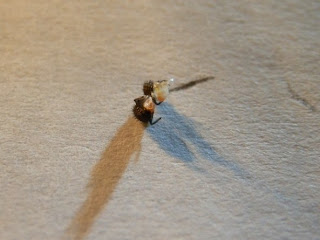At the moment, I'm not sure which type of ladybirds these will turn out to be, but the majority of ladybirds in our garden this year are 2-spot. So perhaps, that is what they will end up being.
I had found the ladybird eggs on some garden wire that we were using to support an Apple tree. I had gone to wind the wire a bit further to keep re-align the tree, so unfortunately a couple of eggs were destroyed before I had see the eggs.
 |
I had read that the eggs would take around 5 days to hatch, so I expected that I would see some larvae around the 18-19 of May. Around this time I didn't see much difference in the eggs and had decided that I would keep them for a couple more days before, sadly, getting rid of them. I was sure that I'd done something wrong.
Then on the late evening of the 20 May, on a random check of the eggs, imagine my surprise when I peeked into the tub and saw some black blobs! Some had hatched and I took a photo of them through my hand lens. Some, however, were still in the process of hatching, so I popped them on a piece of paper to get a better look.
 |
| Already hatched |
 |
| So tiny |
 |
| Ah, allow me to perform the introductions: Predator meet prey, prey meet predator. I'm sure you'll be attached at the hip in no time... |
So now the larvae is about 5 days old and they seem to be doing really well. The branch that I initially put into the tub has produced many aphids for them. This is because aphids are asexual meaning that they don't have sex to reproduce - instead they just clone themselves. A fact of particular interest is that the aphids can already have their offspring developing inside them at the same time they are born! Therefore it is a very short time between generations. But all this cloning means that there have been no adaptations formed as a defence against the ladybirds - perhaps the pure quantity of aphids that can be born as high speed is enough for now!
 |



Hi Tim. Really enjoyed reading (and seeing photo's) of your blog at 5 O'clock this Saturday morning. Hopefully, you will have part 2! Keep up the good work> Norman.
ReplyDeleteHi Norman! Thanks for reading - glad you liked it. I'll let you know if there's a part 2.
Delete